If your business has experienced a significant shift in how and where your employees work, you might be looking for the perfect time tracking tool to help you and your team stay productive. But there are so many time tracking apps available now. That’s why we’ve put together this in-depth Harvest review to share what we’ve learned from integrating with and using one of the industry’s most popular time tracking solutions.
If you want to collect all the information you need, and some you may not have even considered, stick around because we’ve got you covered in this comprehensive Harvest review.
An Overview of Harvest Time Tracking
Do you have questions about how your team is spending their time? Are you unsure how much different projects cost in comparison to what they deliver? Are you in the dark about your invoices or billing?
The Harvest App can help you make sense of all that and more through their easily trackable data.
A crucial task when you have employees, especially remote employees, is tracking time worked. With Harvest, you can set up each job with a timer runs until they finish the work.
Easily integrate several other tools like project management, finance and accounting, issue tracking, customer support, communication, productivity, contracts, proposals, analytics, and more. Harvest offers a full package to help you complete your daily tasks and know that it’s done accurately.
How Do Time Tracking Apps Work?
You can easily access and track the time worked with specific clients, for different tasks, and projects as a whole. You can also easily add notes to each category to organize everything in one place.
Wherever your teams are based, from in-office to remote, you don’t need to concern yourself with micromanaging their time or losing track of what they do each day. Harvest time tracking integrates all of your team logs and stores it in a single, convenient location.
With one quick look, you can see which team members are tracking their time, how many billable hours each person has accrued, and catch any discrepancies between what was assigned, and what was done.
The system tells you not only the vital information about how your unit works but provides insight into who is nearing burnout and who may need more work assigned.
Each week, you will have an overview of the number of billable hours for each employee and the coloring changes based on each individual’s workload. The software also provides you with a daily, color-coded breakdown of the week’s assigned work and everything completed.
Additionally, you can set up automatic reminders for your employees to remind them to submit their worked hours, and you can approve or deny their timecard.
Harvest Time Tracking Review
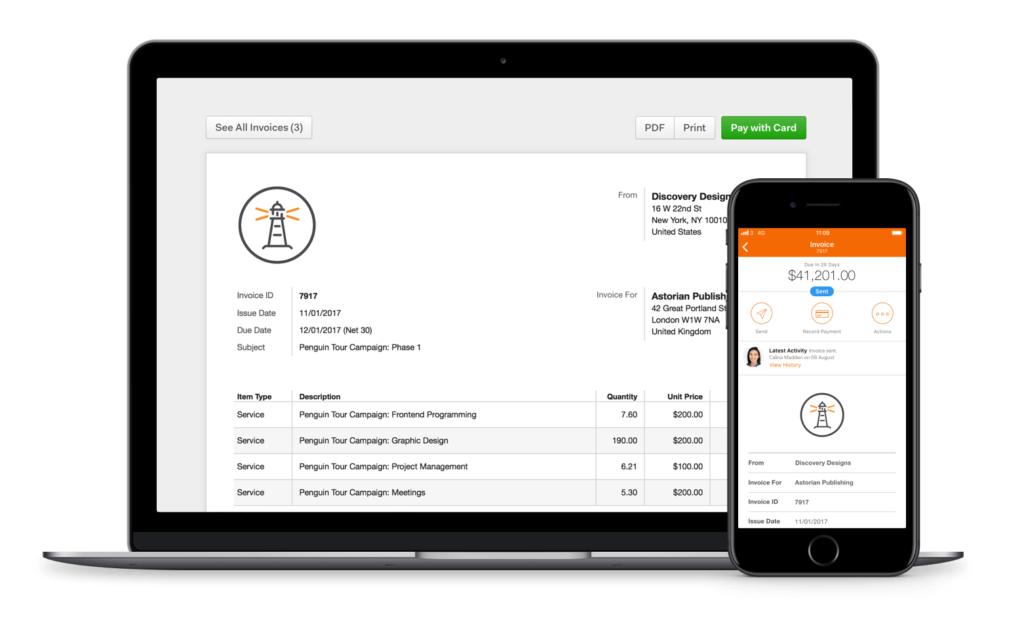
Because of its ease of use and comprehensive team insights, Harvest is one of the most popular tracking apps on the market. It’s able to handle relatively complex data requirements while still being pretty user-friendly.
While Harvest comes with the standard tools like time and expense tracking, reporting, analytics, timesheets, and more, it also helps you create more accurate invoices. While it can’t do payroll for you, it can help you quickly review data and make the most of your time.
A few places Harvest shines is when it comes to two of the most important areas in time tracking: Compliance and Data Structure.
Its suite of useful extensions, apps and integrations make it incredibly easy for your team to stay on top of timesheets and track time wherever they’re working.
The flexibility of its configuration, allowing you to structure your data in just about any way you’d like to match up to estimates or other important reports.
Harvest Review: Compliance Features
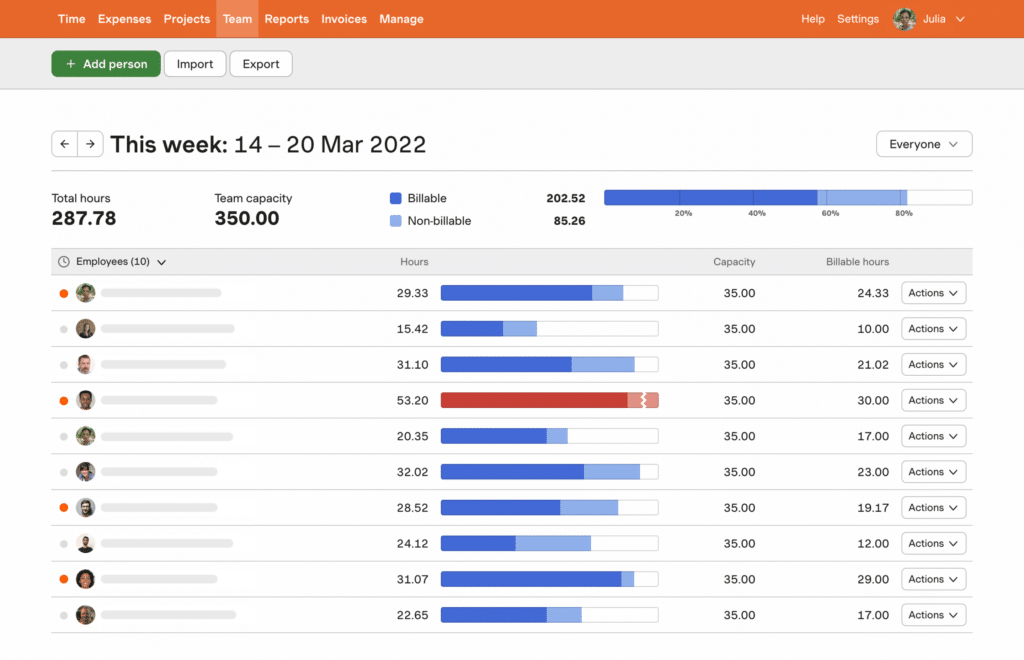
Timesheets are only useful if your team actually fills them out.
This is where the Harvest timesheet really shines! It makes up for some small gaps in reporting by being a simple system for tracking time for small businesses and providing tons of integrations and extensions your team can stay on top of their timesheets.
Between their Mac and Windows apps, Mobile Apps, Chrome Extensions, and integrations with major project management platforms, you can put a Harvest widget just about anywhere.
From in-house teams to remote workers, you will quickly see how everyone works and what projects they’re doing.
They also feature a useful Google Calendar integration and integrations with device monitoring tools like TimeBro making it easier to reference calendar events and device activity while filling in timesheets.
As a manager, it’s easy to pull user reports or set up timesheet approval workflows to monitor compliance and make sure your team is staying on top of inputting your precious data.
Pssst! Ever wonder what to do with the time tracking data you’re collecting? The Agency Profit Toolkit is totally free and gives you input sheets to calculate your project profitability on the spot.

Grab your copy now at the link below!
Harvest Review: Data Structure and Project Management
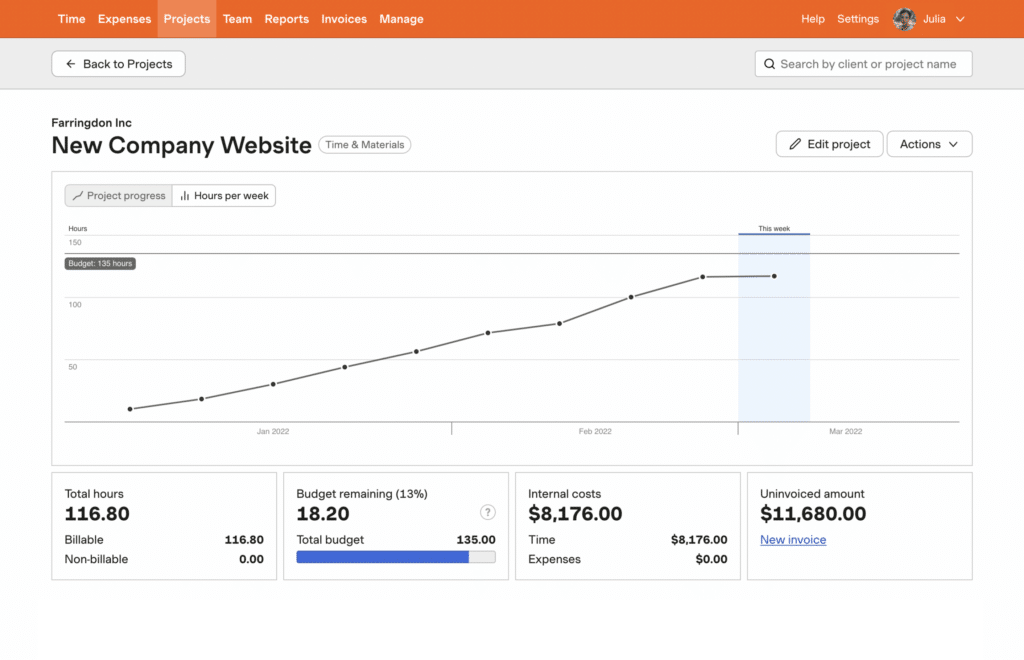
Harvest makes it easy to customize the way data and projects are structured to match estimates and the operations team’s reporting needs.
The project configuration wizard allows you to set budgets at the project level, or down at the task or person level. Budget by rates or hours, and set projects to time and materials, fixed fee, non-billable and recurring formats.
This is truly one of the most important pieces of what makes Harvest such a fundamentally great tool. The fact that it’s able to be present inside of project management tools through integrations, but can still re-map data to a consistent structure is a key feature that’s worth choosing it for.
While the flexibility offered by Harvest around how projects and tasks are structured can work against you – a bit of intentionality when setting it up means you can almost certainly achieve a data structure that lends itself to useful data in the future.
Accounting, operations, and your entire management team will appreciate the data customization available in Harvest.
Harvest Review: Best Features
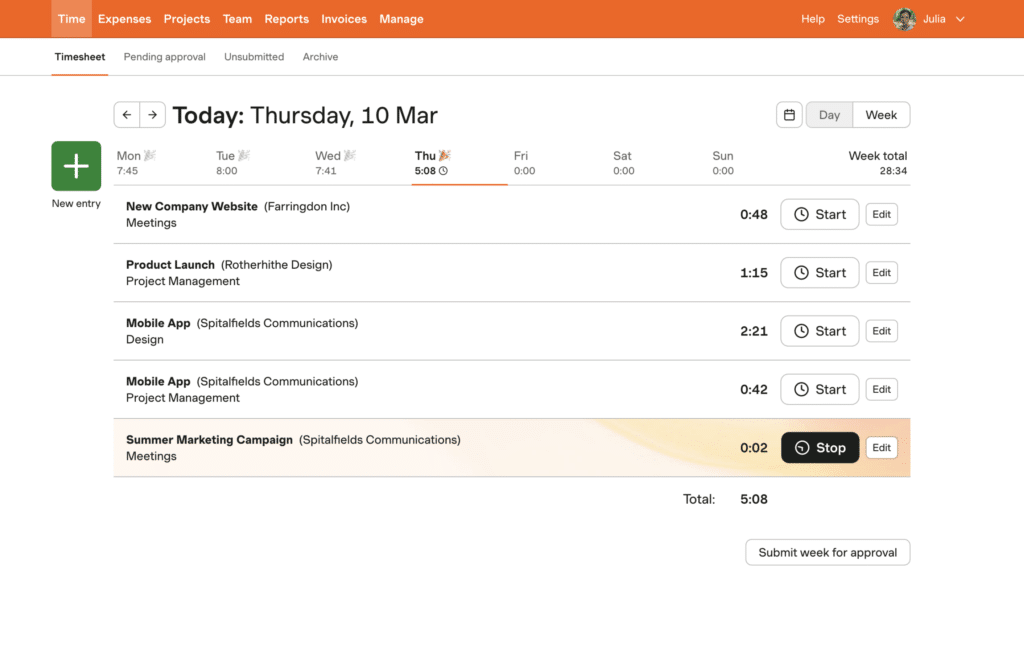
There are many beautiful features with the Harvest app that can help you manage your team, projects and time.
The tools listed in the Harvest Software Review will help you find the most effective ways to pay your teams and charge your clients. The program has standard expense-tracking features that you can record for billing, travel expenses, and any other costs you may often forget to consider. You can even upload and attach receipts! The mobile app makes keeping track of time and expenses on the go easy and fast.
The team management feature gives you visibility on how everyone on your team spends their working time. As new people join your team, you can adjust the capacity for all active people and the number of hours everyone is available and expected to work.
This feature comes in handy if you’re concerned that some individuals are over or underworking so you can keep your team at optimal performance.
Are you a big fan of reports that let you see all of your team data in one place? Harvest uses easy bar graphs with color-coded information that allows you to quickly see how everyone is doing and scale the data to read for any time you want.
While Harvest does fall short on reporting a few key metrics like Utilization (which they calculate based on hours tracked, not based on capacity) it does enable you to export rich reports that can be manipulated outside of Harvest for more in-depth analysis.
Harvest Review: Pricing and Plans
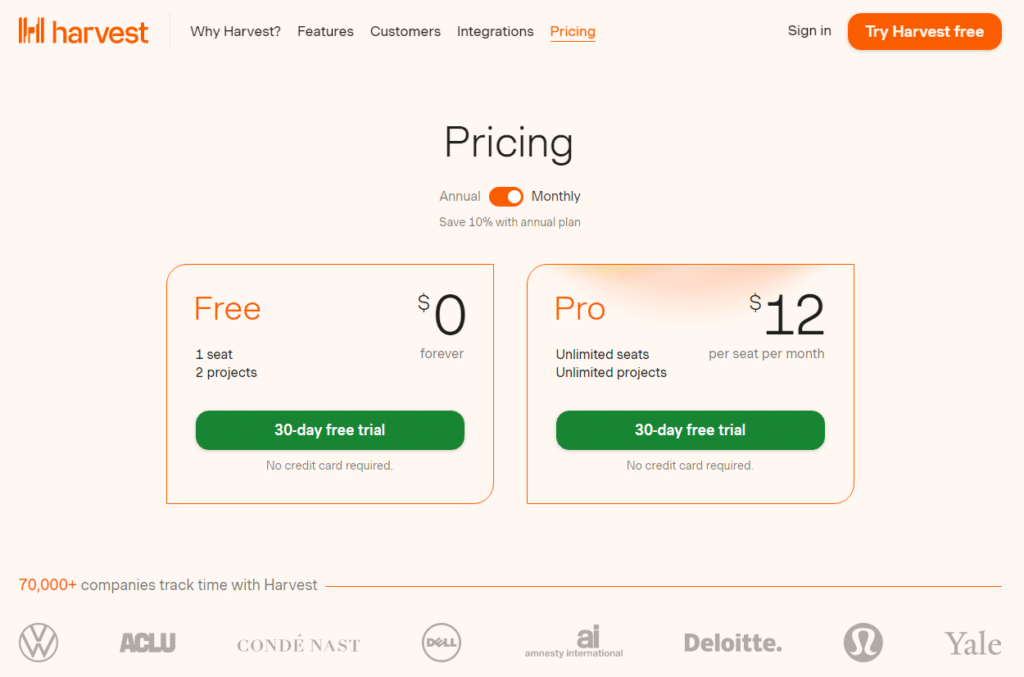
One of the most fabulous things about Harvest for those on the fence is a comprehensive free plan you can use when you get started. If you don’t feel comfortable committing, but you have multiple people who need access for a thorough trial, you can also try the Team account free for 30-days. The differences between the plans are, thankfully, easy to understand.
- Free 30-day trial. Full access to the App and no credit card is required.
- Free for one person and two projects, forever.
- Pro Account is $12, charged per person, per month. For unlimited people and unlimited projects.
- Pro Account is $10.80 charged per person, per month but billed annually. For unlimited people and unlimited projects.
While the prices may be slightly higher than some of the other time-tracking apps on the market, few are as easy to use and implement as Harvest. The versatility of the tracking capabilities and the scheduling tools make this a great choice to fill your business needs.
How to Setup and Use Harvest
The first time you sign in to your Harvest account, you should expect to spend around 15 minutes exploring the apps navigational tools and customizing your specific workspace. Take the time to establish all clients, employees, and projects you will manage through the App and send out invitations.
This could take you much longer if you’re planning on importing a long list of existing clients, projects, or team members. However, Harvest does offer an Import feature for many of these fields which can really speed up the process.
You can adjust the color-coding that will automatically connect to your projects, so it makes the most sense to you and can be easily understood at a glance. Browse through the different templates for invoices, both standard, and retainer, and input your details to expedite future use.
Harvest Time Tracking App
When you log in through the web, you will have all the tools that you need in the interface.
You can also download apps for macOS, iOS, and Android, but Windows and Linux users won’t have that option. Downloading the App is perfect for tracking tasks when you’re on the go or offline, but they’re little more than a timer.
As Harvest tracks the time you spend on different tasks, you can keep an eye on the menu bar’s timer for Mac app users. Those who are using Windows or Linux will need to keep the web page open to monitor their time.
Taking Notes
If you’re a note-taker, there is a field you can add details to for the task in progress. If you’re working with a team, utilizing this capability can help ensure everyone understands what they are expected to fulfill along the way.
Harvest Pros and Cons
Summed up, here is our take:
Pros
One of the things we love about Harvest is that it’s able to be used on the platform of your choice (desktop, mobile, browser, chrome extension) to take some of the friction away of tracking time which in reality probably isn’t the most exciting part of your team member’s day.
Along with that, Harvest has a set of features that help improve compliance. For example, required fields allow managers to enforce specific metadata that time entries always contain (like a client name, or a project name) and won’t allow entries without those fields to go through. It also has an optional timesheet approval workflow which allows for the routing of timesheets to a manager to review them for good hygiene and compliance. Moreover, the flexibility there that allows you to configure your time entries however you would like them really just makes it a tool that works in most scenarios. Big win!
Cons
There aren’t many things that we would expect Harvest to be good at that it isn’t good at, so we’re reaching a bit with these critiques.
For example, we don’t generally expect time-tracking tools to be great at reporting, and Harvest is no exception to that.
In a sense, Harvest doesn’t really have much in the form of reporting beyond simply being able to visualize the time-tracking data you’ve inputted in a few different ways, and export it to get more granular insights.
It actually has pretty nice insight at the project level, but that’s about the extent of its reporting capabilities.
Even some of the simplest metrics like Utilization are missing from their reporting system, that’s mostly due to the fact that they don’t have a concept for capacity in their data model. The closes thing they offer to utilization is a percentage of billable hours vs tracked hours. Clearly, that’s not going to work as a utilization for a host of reasons, the main one being that it would require 100% of capacity getting tracked in Harvest 100% of the time. More depth on Utilization in this post.
Another idiosyncrasy to be aware of is that Harvest has some strange inconsistencies when it comes to how it applies changes to historical data for various objects. For example, if the hourly rate on or budget on a recurring project is changed, that change will be applied to all the past months of that recurring project. The same goes for cost rates or bill rates for employees which can throw off a lot of historical data and reporting. In some cases, Harvest’s simplicity flirts with naivete and comes at the cost of data integrity.
As such, Harvest is no exception to our general rule when it comes to time tracking tools – use it for time tracking, and not much else. Rely on external tools and data management processes to handle reporting and things like modeling capacity & planned work.
Aside from that, Harvest is limited to a 3-object hierarchy, so if you’re looking to add more granularity to your reporting you’re going to have to stop at 3. What we mean by that, is that if you would like a time entry to include:
- Client
- Project Name
- Project Phase
- Notes
In our experience, the forcing function of being restricted to 3 levels of hierarchy ends up being a good thing in most instances as it forces a simpler data schema and pushes extra metadata into notes, but it can be restrictive in some edge cases.
While there are ways to use naming conventions in notes, or integrations to drop things like Task-IDs or other metadata into the notes section to be parsed later and stitched together with other datasets – that’s going to be a little too advanced for most people. So if there’s a reason you need a lot more metadata on a time entry, this restriction might be a deal breaker for you.
Harvest Alternatives
Some strong alternatives to Harvest that you can consider are:
Ultimately, the best time tracking tool for you is one that your team will use. The tool itself might not do everything you want, but at the end of the day the most important thing for your time tracking tool to do is allow your team to track their time so you can gain insight from it.
Harvest Integrations
With over 70+ integrations that Harvest offers, there is no question that the tool is mainstream enough to connect it to most of the tools you use (assuming your tools are also mainstream). Because Harvest has been around so long and is so widely adopted, it’s generally pretty easy to get it speaking to the rest of your stack.
In terms of integrations that we think are useful for you to consider, focus on those that will improve the efficiency and productivity/ease of use for your team. That being calendar connections (like google calendar), device monitoring tools (like TimeBro), project management tools (like Asana) and other data connections such as IFTTT. These can be really useful for reducing time-tracking friction and improving compliance, and pulling additional metadata into Harvest time entries to allow for richer nights.
Harvest User Reviews
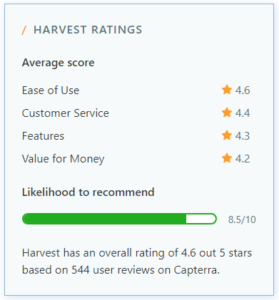
Harvest has a strong rating on Capterra with a 4.6/5 star rating with over 500 reviews.
The majority of the positive sentiment from users note ease of use, reasonable pricing and flexible options on how users can go about tracking their time.
Conversely, the negative reviews outline a few half-baked features inside of the expensing side, lack of ability to handle edge cases because of it’s simplicity, and (a very common one) is lack of automated reminders or other automated features.
Where to Start with Time Tracking Software
Are you ready to take your business to the next level and finally get a handle on all the different employees, clients, and projects you need to manage?
Based on the Harvest review, time tracking isn’t the only thing this program can do, and with the regular influx of new integrations, the value of this App keeps increasing!
For more information about Parakeeto and to better understand why we created this integration was created, learn more about us! For more industry insight and agency profitability articles, check out our blog.
Why Time Tracking doesn’t paint the full picture…
Getting your team to track their time is the first and most important step to getting more timely and detailed insights into your agency’s performance. But you know what they say “It’s not the time-tracking data, it’s how you use it!”

Parakeeto specializes in helping agencies measure and improves their profitability. We do so by helping agencies design, implement and run agency operations systems that measure their most important metrics. We can even become your fractional data operations team, taking reporting on agency performance off your plate entirely and helping you interpret and act on those insights.
If you’re struggling to figure out the right tools for things like time-tracking, project management, resource planning and finance. Or you feel you have the right tools but are struggling to get clean and consistent data flowing out of them – we can help.
Our system and frameworks aren’t biased towards any one particular set of tools – and are customized to your agency’s unique context.
Learn more here, or apply for a call with an agency profitability consultant here!

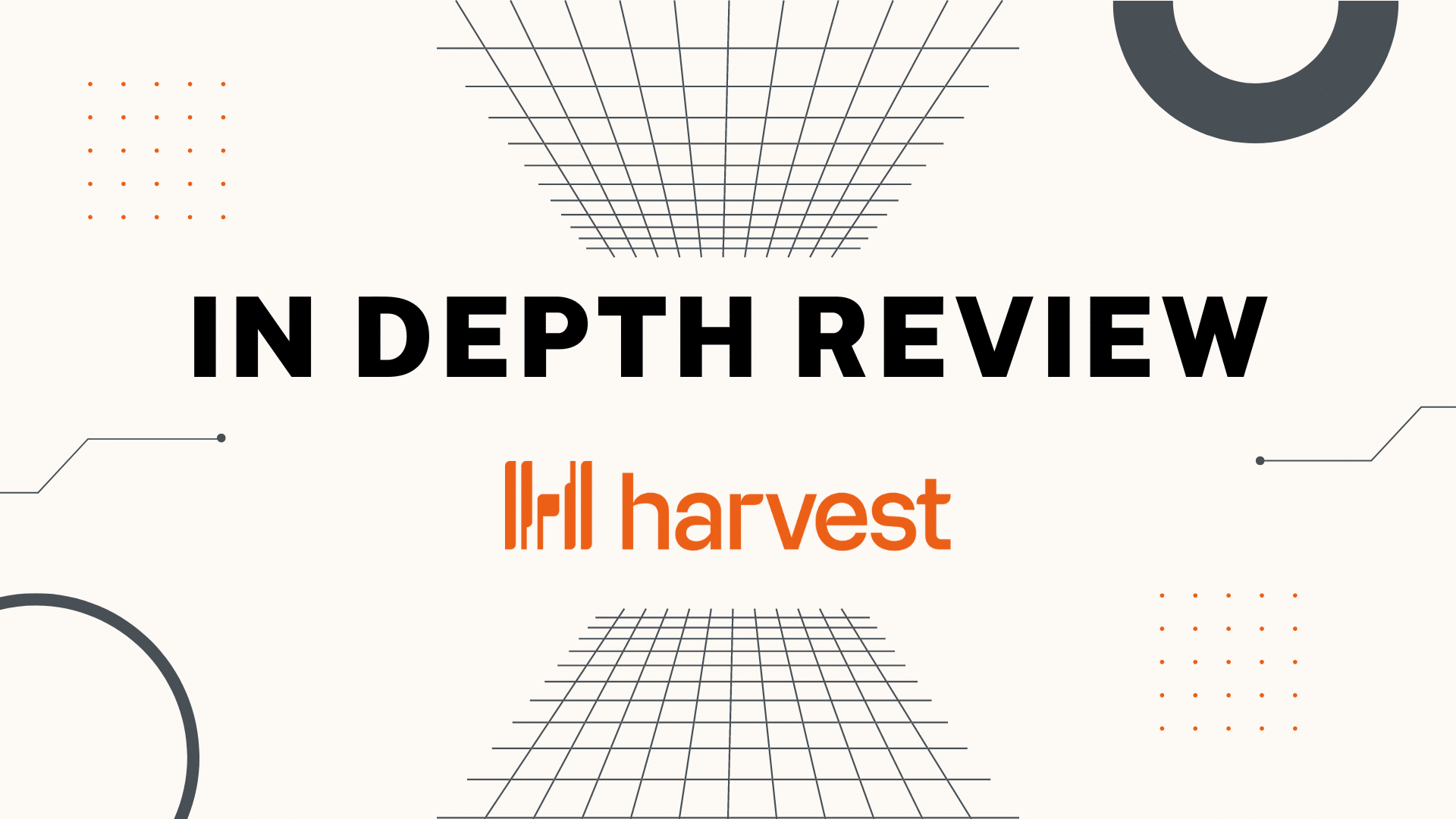



0 Comments